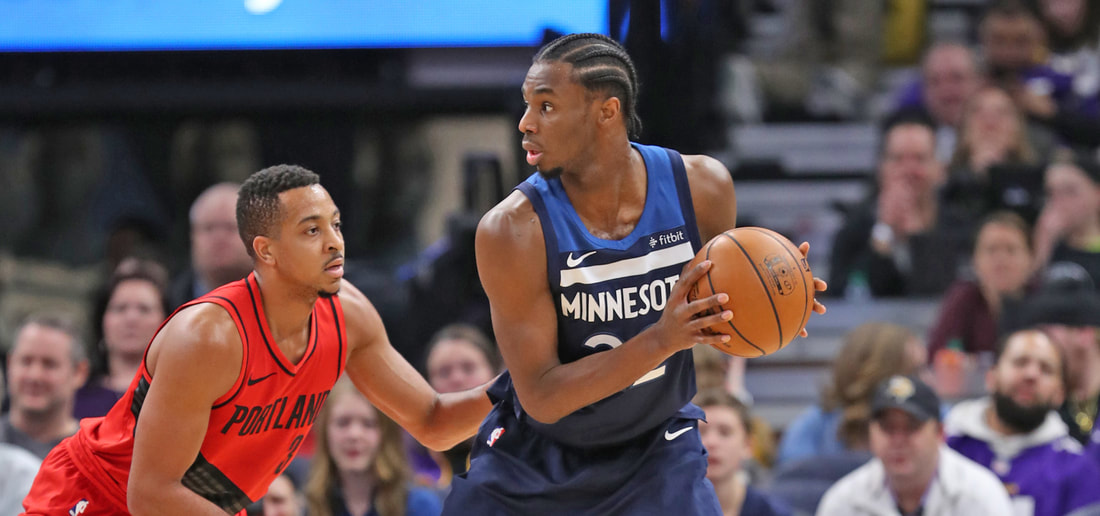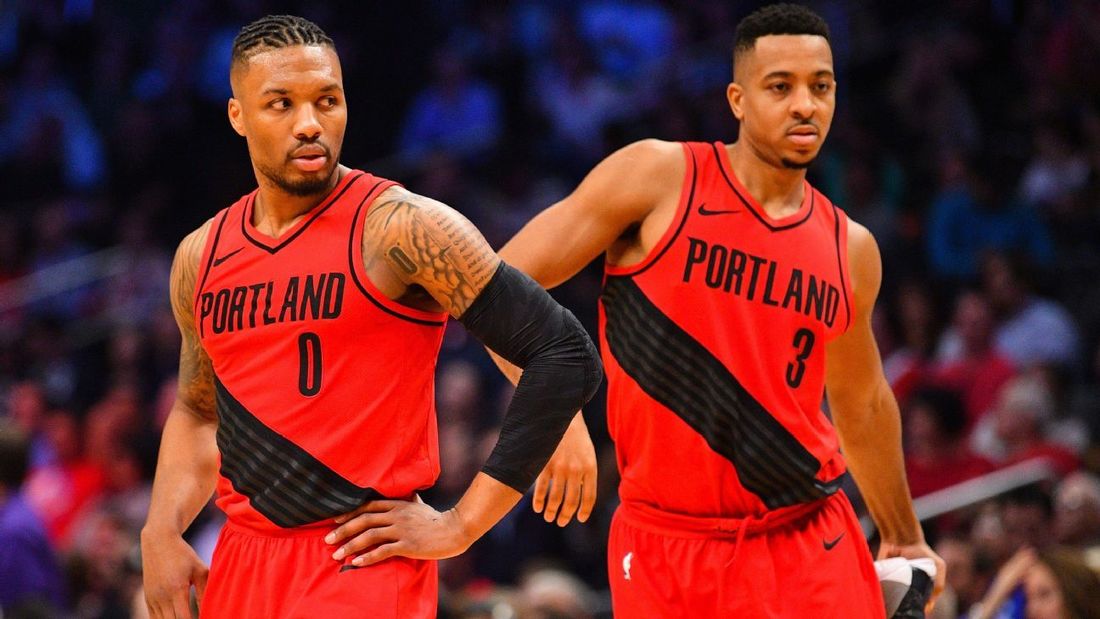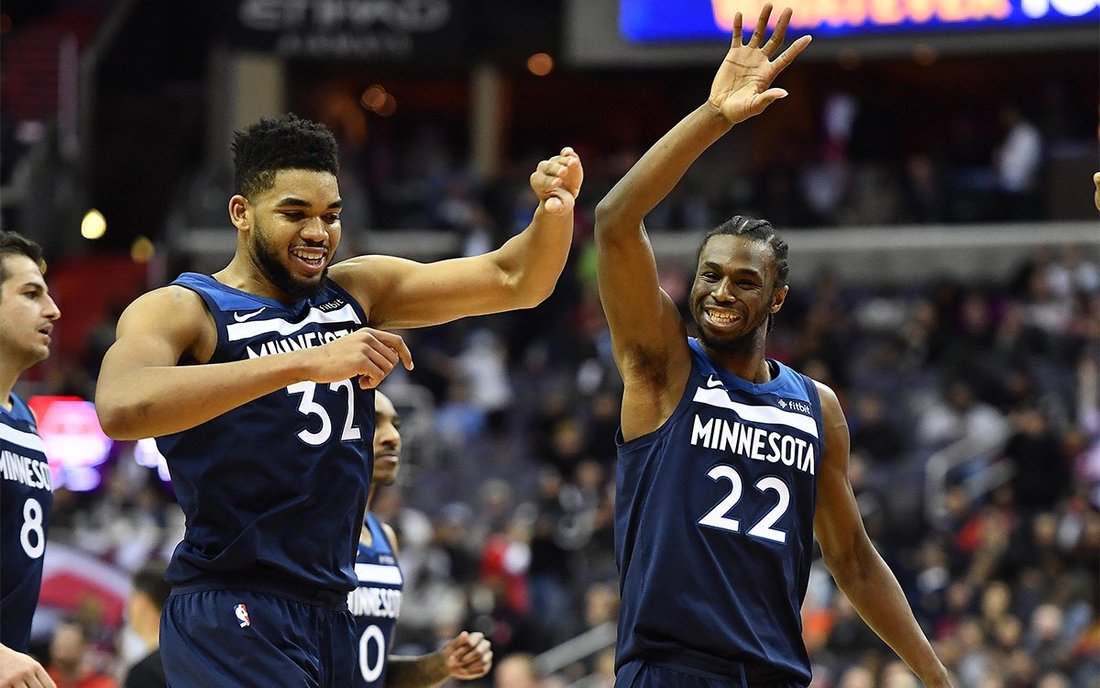|
As the eyes of many NBA fans shift towards the postseason, some front office executives are thinking about how they can improve the fates of their franchises that are not currently vying for postseason play. The pre-draft process is filled with tons of scouting, evaluation periods, internal discussion and workouts for some of the hopeful rookies that want a spot in the NBA. Taking the drafting needs and picks into consideration, financial considerations can paint the biggest picture to what decisions will be made beyond the draft. Trading some players, utilizing cap space for taking on others, and preparing for free agency all are highly informed by the team's salary situations – after all, the NBA is a business. Both the Minnesota Timberwolves and Portland Trail Blazers are entering expensive tax territory next season, and have intriguing summers where they must balance limiting their costs and improving their benches to compete. Portland Trail Blazers 2017-18 Record: 49-33 2018 Draft Picks: 24th Restricted Free Agents: C Jusuf Nurkic, PG Shabazz Napier, SG Pat Connaughton, PG Wade Baldwin IV Unrestricted Free Agents: C Ed Davis Other Players of Note: C Georgios Papagiannis (non-guaranteed contract), F Jake Layman (non-guaranteed contract) Committed Salary: $113,945,528 Luxury Tax Room: $5.4 million After a surprising first-round sweep at the hands of the New Orleans Pelicans, Portland's entire organization was sent reeling. The Blazers have $5.4 million between them and the luxury tax, and $11.4 mill to the tax apron with one starter and some of their key bench pieces coming into free agency. The Blazers were able to duck the luxury tax last season, but doing so next year would mean heavily shedding salary or letting restricted free agent and starting center Jusuf Nurkic walk. President Neil Olshey will prove to be an incredibly shrewd negotiator if he can simultaneously avoid the luxury tax and keep this team competitive in the Western Conference. Order of Operations 1. Decide if Lillard and McCollum are the right pairing Portland will pay roughly $60 million each year until 2021 for the starting backcourt of Damian Lillard and CJ McCollum. The two are both impressive individual scorers, but are a bit of the same player in terms of style: volume scoring shooters that are average at best on the defensive end. Portland's sweep at the hands of the Pelicans opened their eyes to their ability to guard and how elite perimeter defenders can completely shut down the Blazers' offense. There are rumors that McCollum could be on the trading block as part of a move from the organization to become a bit more well-rounded. The first piece of approaching the offseason comes with deciding if these two can go another season together, or if the Blazers must part from one if they are to stay in the top-tier of the Western Conference. Assuming McCollum stays in Portland, here are the rest of the options for their summer: 2. Will they match a big offer for Nurkic? Perhaps the biggest question for Portland is how deep into the luxury tax they'll go in order to get Jusuf Nurkic back. He's certainly one of the biggest pieces for the franchise outside of the backcourt, both for his post scoring and the defensive potential he still oozes. Olshey will likely start conservative with a $10-12 million annual offer, just enough to ensure he isn't poached away by any team's Mid-Level Exceptions. However, offers that go above $12-15 million a year will push Portland into the luxury tax already, with only 11 players under contract -- and over $120 million tied up in salaries for next season. The repeater tax would be almost unavoidable, and that is a dangerous territory to be in if the organization doesn't truly believe Nurkic, Lillard and McCollum are a championship-level trio. You also have to factor in the good play of Zach Collins, the rookie big man that could be the starting center moving forward, in any desire for the Blazers to head into the luxury tax for Nurkic. All it could take is one team to swoop in and offer Nurkic the tender of $15 million a year for four years before the Blazers back down and lose a key part of their future foundation. Whether that precipitates a trading of McCollum/ Lillard or is part of the sacrifice to keep the duo together remains to be seen. 3. Consider using picks to get off the salary of Evan Turner or Meyers Leonard Olshey and the Blazers missed a window a season ago to get rid of Evan Turner by packaging multiple of their three 2017 first-round picks with him to a team with cap space like the Sacramento Kings. A year later, the cost of unload Turner is even more expensive in another cap crunch summer where fewer teams have cap space and more teams are vying for it. But if Portland doesn't feel the need to deconstruct or shake up their two big stars, the next best alternative might be clearing cap space by trading Turner or Meyers Leonard now. The Turner contract costs a lot more to unload, while Leonard might only cost one first-round pick. Either way, the Blazers should explore every avenue possible to lighten their tax bill. Trading a player away for next to nothing for a second consecutive season isn't ideal, but it could be the only way for Portland to keep things together long-term. 4. If they keep the pick, get a shooting forward/ wing Portland has to believe that their lack of spacing from the 3 and 4 spots, and lack of multi-positional defenders, are some of the biggest flaws with the way the roster is currently constructed. That could also be the way to replace one of Ed Davis or Jusuf Nurkic naturally; expect there's enough depth at the 5 to downsize just a little bit naturally. Picking 24th, there should be plenty of ready-to-play 3-and-D wings that also qualify as some of the best guys left on the board. Boise State's Chandler Hutchison, Tulane's Melvin Frazier, Oregon's Troy Brown, Maryland's Kevin Huerter or Duke's Gary Trent Jr. could all be options available for the Blazers that make immediate impacts, space the floor and keep the ball rolling in the direction it has been for Portland. 5. The Allen Crabbe trade exception vs. free agent money Portland could go a lot of directions in the late-June or early July periods here, mainly revolving around decisions with Nurkic and McCollum. If McCollum stays, there are essentially two strategies the Blazers can take regardless of Nurkic: not pay to get off a big contract and retain their own free agents, or pay to unload a contract and add subtle tweaks to the roster. If part two is the path they take and the Blazers are in the buyers market at any point for a new player, the dilemma becomes this: should they use the Mid-Level Exception to sign a new player or the $12.96 million trade exception from Allen Crabbe they have. The Crabbe trade exception expires on July 25th. Personally, I'm a proponent of using the Crabbe exception instead of eating into the limited budget on free agency through the MLE. Portland, depending on how much they can shed salary-wise, but will be careful not to hard cap themselves by offering the Non-Taxpayer MLE of $8.8 million. Instead, the max value they'd likely be able to use is a $5.45 million multi-year deal. With the Crabbe deal they can go up to $12.96 million to get a player via trade AND inherit their Bird rights, allowing Portland to retain them above the cap in future years. Players like Courtney Lee from the Knicks, Wilson Chandler from Denver (if he exercises his player option), Jared Dudley from the Suns or Nikola Vucevic from Orlando could be attainable options that play right away and fill the immediate holes they'd create by shedding salary or letting some of their restricted free agents go. Of course, Portland doesn't have to use the entire $12.96 million exception, and can budget themselves based on how much space they have. Work through the math here with me... if they can shed Evan Turner's deal without taking anything back, and re-sign Jusuf Nurkic for $14 million a year, they'll have ten players on the roster and about $8 million between them and the luxury tax. Factor in the first-round pick and that comes to about $6.5 million from the luxury tax and $12.5 million from the tax apron. They can then bid modestly on guys like Napier and Connaughton, and then have around $7 million between them and the luxury tax. Would that be enough for the team to go after a guy like Justin Holiday of the Bulls or Jonas Jerebko from Utah? There are ways to go about the financial cutting this year where the Blazers are making minimal tweaks and trying to get better without blowing up their core trio of the future. Of course, that comes at a cost: they still spend a great deal of money, approach the tax apron and would have to give up multiple first-round picks. The most likely scenario is that Portland loses their starting center, but there are ways to keep him and add shooting on the wings. Minnesota Timberwolves
2017-18 Record: 47-35 2018 Draft Picks: 20th (from OKC), 48th Restricted Free Agents: F Nemanja Bjelicia, G Marcus Georges-Hunt, F/C Amile Jefferson Unrestricted Free Agents: PG Derrick Rose, G Jamal Crawford, PG Aaron Brooks Other Players of Note: C Cole Aldrich (only $2.05m guarantee if waived before June 20th) Committed Salary: $115,133,979 Luxury Tax Room: $7.5 million It was a little bit of a disappointing season for the Timberwolves, but it really shouldn't have been. Their core spent their first season together and are still young. Youngsters Karl-Anthony Towns and Andrew Wiggins both struggled with their defensive consistency, and their role players and thin bench would creep up on the team eventually. After an admirable fight against the Houston Rockets in the first round, Minnesota is now facing the additions of Andrew Wiggins' max extension and a huge deal for Karl-Anthony Towns a season from now. How will that impact the ways Tom Thibodeau and company shape the roster? Order of Operations 1. Fix Thibodeau's minutes allocation Look, the offseason moves that the team makes won't matter much if Thibodeau doesn't lighten the load he puts on his starters and utilizes his bench more. Agents are starting to be hesitant to send their veterans to Minnesota for a bench role based on Thibs' history of barely dipping into his bench and playing his key pieces nearly 40 minutes a night. There's plenty of data out there that suggests this has a negative effect on the Timberwolves and their best players, regardless of how young or tough they are. Frankly though, it doesn't matter what offseason moves the Wolves make to add more pieces to their roster if Thibs only plays a top-seven in the rotation. With Jeff Teague, Jimmy Butler, Andrew Wiggins, Taj Gibson, Karl-Anthony Towns, Gorgui Dieng and Tyus Jones all coming back next year and the 20th pick coming in the draft, that rotation is already set. Unless Thibs commits to changing his philosophy a bit, there's little to no point to addressing free agency for Minnesota. 2. Lock up Towns & avoid the tax this year There's little reason to let one of the most skilled big men in the NBA even sniff free agency next summer. Minnesota should be prepared to break the bank on him and offer the maximum five-year, nearly $160 million deal whenever their negotiations can take place. While there's a little more complication to ironing out the kinks in a max contract than simply signing the dotted line, Minnesota knew that spending a boat load of money would be necessary when they found out the talent-levels of Towns and Wiggins then traded for Butler. The Wolves likely become a luxury tax team somewhere down the line. It's important to make sure that time isn't next season. With six open roster spots and $7.5 million between them and the luxury tax, ducking that number becomes a priority for the future. They could create a seventh roster opening and add $4.9 million or $5.8 million to their summer budget by waiving or stretching the contract of Cole Aldrich by the 30th of June, something they're likely to do. Seven roster spots, two draft picks and between $12 and $13 million to play with this summer? Certainly more enviable than some other situations for contenders around the league. 3. Draft around the Big Three With the 20th pick in the draft, Minnesota should be searching for a piece they believe can coexist long-term with the trio of Andrew Wiggins, Jimmy Butler and Karl-Anthony Towns. What kind of piece could that be? A versatile 4-man, a long-term point guard or simply outside shooting. There are plenty of options available. Keep in mind: Minnesota also has last year's first-round pick Justin Patton still developing, and while raw he has a great deal of upside. One area the Wolves should be staying away from is at the center spot. Some names to watch for here: Ohio State's Keita Bates-Diop, Aaron Holiday of UCLA, Troy Brown from Oregon, Villanova's Donte DiVincenzo or Boise State's Chandler Hutchison. Minnesota can also find an intriguing piece late in the second-round that could help fill out their roster. Instead of trading that pick away or cashing it in on a draft-and-stash guy, the Wolves should use it as an opportunity to grab a player that can help now while also minimizing the cap hits of getting more bodies on their roster. Minnesota can likely sign two players here for less than $3 million next season, keeping their budget for free agency in tact. 4. What to do in free agency From the restricted free agency of 30-year-old Nemanja Bjelicia to properly estimating the external value of non-Bird free agent Derrick Rose, the front office in Minnesota needs to guess right on what their own guys are worth if their game plan is to work. Retaining Bjelicia, who the Wolves will likely tender for $4.94 million, shouldn't eat enough of their remaining cap space after the draft that Minnesota cannot effectively bid for players using their Mid-Level Exception. That would make the line in the sand for him somewhere around that $5 million mark... and that would pose a question of whether Bjelicia is better off just accepting the tender and being an unrestricted free agent next summer when more money is expected to circulate on the market. The opposite goes for a guy like Derrick Rose, who likely gets interest for higher payment than a minimum contract only from Minnesota. Is their front office patient enough to balk on him, focus elsewhere and then offer that minimum deal later in free agency? Both questions have a profound effect on their likely usage of the non-tax MLE, slated at a $5.5 million max. Minnesota will look to target some blue-chipper 3-and-D players that can thrive next to both Wiggins and Butler with that budget. Mario Hezonja from Orlando could be a nice option for the Wolves to consider. There is one other option here that could open up the full usage of that $5.5 million and allow them to bid a bit higher on Bjelicia: draft-and-stash in the first round. While I don't advocate for that from a financial standpoint (as the first-round pick at #20 is a great cap-saver), it is possible if the Wolves believe in a more aggressive win-now approach and think they accomplish that better through free agency than the draft. 5. How untouchable is Wiggins? Despite being committed to Wiggins with their max extension signed last year, it still seems entirely likely that the Wolves end up flipping him next year once he's trade eligible. That would be akin to what the Clippers did this last year with Blake Griffin, re-signing him to a mega deal and then flipping him soon after. We know Wiggins hasn't progressed the way the front office or ownership have hoped, so how vital is he in the long-term vision of the franchise? Once they enter that luxury tax territory, the pressure turns up for the franchise to win more games and make a deep postseason push. The point is this: if Wiggins doesn't fully aid that pursuit next season or the year after, this winter could be the time to shop him. Those plans must already be talked about and explored from a front office perspective.
0 Comments
Leave a Reply. |
Adam SpinellaHead Boys Basketball Coach, Boys' Latin School (MD). Archives
September 2021
Categories |



 RSS Feed
RSS Feed
